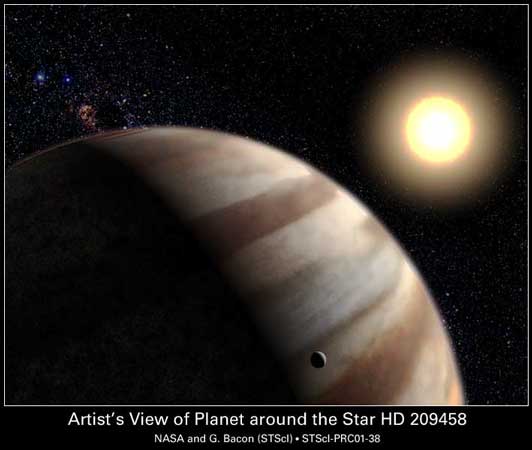Water Found in Extrasolar Planet's Atmosphere

Updated 1:15 pm ET
Astronomers have detected water in the atmosphere of a planet outside our solar system for the first time.
The finding, to be detailed in an upcoming issue of Astrophysical Journal, confirms previous theories that say water vapor should be present in the atmospheres of nearly all the known extrasolar planets. Even hot Jupiters, gaseous planets that orbit closer to their stars than Mercury to our Sun, are thought to have water.
The discovery, announced today, means one of the most crucial elements for life as we know it can exist around planets orbiting other stars.
"We know that water vapor exists in the atmospheres of one extrasolar planet and there is good reason to believe that other extrasolar planets contain water vapor," said Travis Barman, an astronomer at the Lowell Observatory in Arizona who made the discovery.
HD209458b is a world well-known among planet hunters. In 1999, it became the first planet to be directly observed around a normal star outside our solar system and, a few years later, was the first exoplanet confirmed to have oxygen and carbon in its atmosphere.
HD209458b is separated from its star by only about 4 million miles (7 million kilometers)-about 100 times closer than Jupiter is to our Sun-and is so hot scientists think about it is losing about 10,000 tons of material every second as vented gas.
Breaking space news, the latest updates on rocket launches, skywatching events and more!
"Water actually survives over a broad range of temperatures," Barman explained. "It would need to get quite a bit hotter to completely break the water molecules apart."
Using a combination of previously published Hubble Space Telescope measurements and new theoretical models, Barman found strong evidence for water absorption in the atmosphere of the extrasolar planet HD209458b.
Barman took advantage of the fact that HD209458b is a so-called "transiting planet," meaning it passes directly in front of its star as seen from Earth. It transits every three-and-a-half days.
When this happens, water vapor in the planet's atmosphere causes the planet to appear slightly larger in the infrared part of the starlight than in the visible portion.
Barman found the water signature after applying new theoretical models he developed to visible and infrared Hubble data collected by Harvard student Heather Knutson last year, which measured the perceived size of the planet over a broad range of wavelengths.
"I simulated the passage of starlight through the atmosphere of the planet, and was able to reproduce the variation that they saw," Barman told SPACE.com. "And since I know exactly what physics and chemistry went into my simulation, I know precisely what caused those variations, and I can attribute those variations to water" or other molecules.
Barman said his discovery would not have been possible without the observations made by the Harvard team. "This is an example of theoretical modeling and observations coming together to help identify something new and interesting about this planet," he said.
- Early Earth Was Purple, Study Suggests
- 30 Billion Earths? New Estimate of Exoplanets in Our Galaxy
- 10 Years of Planet Hunting: Amazing Variety Out There
Ker Than is a science writer and children's book author who joined Space.com as a Staff Writer from 2005 to 2007. Ker covered astronomy and human spaceflight while at Space.com, including space shuttle launches, and has authored three science books for kids about earthquakes, stars and black holes. Ker's work has also appeared in National Geographic, Nature News, New Scientist and Sky & Telescope, among others. He earned a bachelor's degree in biology from UC Irvine and a master's degree in science journalism from New York University. Ker is currently the Director of Science Communications at Stanford University.
